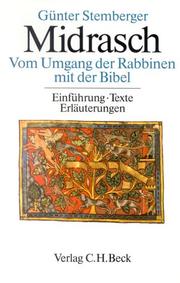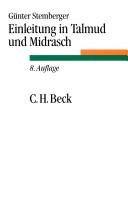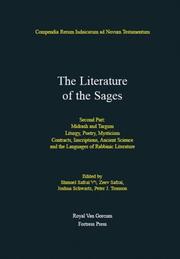| Listing 1 - 10 of 38 | << page >> |
Sort by
|
Book
ISBN: 9782204103206 2204103209 Year: 2014 Publisher: Paris Cerf
Abstract | Keywords | Export | Availability | Bookmark
 Loading...
Loading...Choose an application
- Reference Manager
- EndNote
- RefWorks (Direct export to RefWorks)

ISBN: 3406339107 Year: 1989 Publisher: München Beck
Abstract | Keywords | Export | Availability | Bookmark
 Loading...
Loading...Choose an application
- Reference Manager
- EndNote
- RefWorks (Direct export to RefWorks)
Book
ISBN: 9783161600906 3161600908 9783161600913 Year: 2021 Volume: 461 Publisher: Tübingen Mohr Siebeck
Abstract | Keywords | Export | Availability | Bookmark
 Loading...
Loading...Choose an application
- Reference Manager
- EndNote
- RefWorks (Direct export to RefWorks)
Although it is difficult to define Haggadah exactly, this topic, thus far neglected in New Testament studies, can comprise among other things hyperbole; the addition of names, dates and numbers to an earlier text; glorification of a biblical character; parables to illustrate a statement or principle; and the creation of speeches, even of entire scenes. In addition, it is important in resolving the centuries-old inaccurate alternative of true or false, historical or fictional. The nineteen essays collected in this volume, by leading scholars in their own fields, illustrate in an exemplary way how Jews in Antiquity and Jewish Christians creatively employed haggadic elements in their writings. --
Book
ISBN: 2130429998 9782130429999 Year: 1990 Volume: 2526 Publisher: Paris PUF
Abstract | Keywords | Export | Availability | Bookmark
 Loading...
Loading...Choose an application
- Reference Manager
- EndNote
- RefWorks (Direct export to RefWorks)
Hebrew literature --- Thematology --- Rabbinical literature --- Littérature rabbinique --- 296*1 --- 296.1 --- Hebreeuwse bijbel: targum; midrasj; bijbelcommentaren; haggadische verzamelingen--(algemeen) --- Judaism --- Rabbinical literature. --- Doctrines. --- 296*1 Hebreeuwse bijbel: targum; midrasj; bijbelcommentaren; haggadische verzamelingen--(algemeen) --- Littérature rabbinique
Book
ISSN: 03409570 ISBN: 9783161565014 3161565010 9783161566486 Year: 2020 Volume: 507 Publisher: Tübingen Mohr Siebeck
Abstract | Keywords | Export | Availability | Bookmark
 Loading...
Loading...Choose an application
- Reference Manager
- EndNote
- RefWorks (Direct export to RefWorks)
227.1*1 --- 296*1 --- 296*1 Hebreeuwse bijbel: targum; midrasj; bijbelcommentaren; haggadische verzamelingen--(algemeen) --- Hebreeuwse bijbel: targum; midrasj; bijbelcommentaren; haggadische verzamelingen--(algemeen) --- 227.1*1 Brief van Paulus aan de Romeinen --- Brief van Paulus aan de Romeinen

ISBN: 3406366953 Year: 1992 Publisher: München Beck
Abstract | Keywords | Export | Availability | Bookmark
 Loading...
Loading...Choose an application
- Reference Manager
- EndNote
- RefWorks (Direct export to RefWorks)
296*1 --- 296*2 --- 296*2 Misjna. Talmud. Halachische codices . Responsen --- Misjna. Talmud. Halachische codices . Responsen --- 296*1 Hebreeuwse bijbel: targum; midrasj; bijbelcommentaren; haggadische verzamelingen--(algemeen) --- Hebreeuwse bijbel: targum; midrasj; bijbelcommentaren; haggadische verzamelingen--(algemeen) --- Jewish religion --- Hebrew literature
Book
ISBN: 9023222822 0800606051 9004275134 Year: 1987 Volume: 1 Publisher: Assen Van Gorcum
Abstract | Keywords | Export | Availability | Bookmark
 Loading...
Loading...Choose an application
- Reference Manager
- EndNote
- RefWorks (Direct export to RefWorks)
The literary creation of the ancient Jewish teachers or Sages--also called rabbinic literature--consists of the teachings of thousands of Sages, many of them anonymous. For a long period, their teachings existed orally, which implied a great deal of flexibility in arrangement and form. Only gradually, as parts of the amorphous oral tradition became fixed, was the literature written down, a process that began in the third century CE and continued into the Middle Ages. Thus the documents of the rabbinic literature are the result of a remarkably long and complex process of creation and editing. This volume gives a careful and succinct analysis both of the content and specific nature of the various documents, and of their textual and literary forms, paying special attention to the continuing discovery and publication of new textual material. The contributors are all engaged in academic teaching and research in Israel. Incorporating ground-breaking developments in research, their essays give a comprehensive presentation published here for the first time.
Jewish religion --- Bible OT. Pentateuch --- Talmud --- Rabbinical literature --- History and criticism. --- 296*1 --- #GOSA:II.P.JUD --- Hebreeuwse bijbel: targum; midrasj; bijbelcommentaren; haggadische verzamelingen--(algemeen) --- 296*1 Hebreeuwse bijbel: targum; midrasj; bijbelcommentaren; haggadische verzamelingen--(algemeen) --- Jewish religious literature --- Jewish religious literature. --- Rabbinical literature. --- Hebrew literature --- Jewish literature --- Religious literature, Jewish --- Religious literature
Book
ISBN: 0800607341 9780800607340 Year: 1985 Volume: 3 Publisher: Philadelphia (Pa.): Fortress
Abstract | Keywords | Export | Availability | Bookmark
 Loading...
Loading...Choose an application
- Reference Manager
- EndNote
- RefWorks (Direct export to RefWorks)
Jewish religion --- Judaism --- Rabbinical literature --- Torah (The Hebrew word) --- History --- History and criticism --- 296*1 --- -Rabbinical literature --- -Torah (The Hebrew word) --- Hebrew language --- Hebrew literature --- Jewish literature --- Jews --- Religions --- Semites --- Hebreeuwse bijbel: targum; midrasj; bijbelcommentaren; haggadische verzamelingen--(algemeen) --- -History and criticism --- Etymology --- Religion --- 296*1 Hebreeuwse bijbel: targum; midrasj; bijbelcommentaren; haggadische verzamelingen--(algemeen) --- Judaism - History - Talmudic period, 10-425 --- Rabbinical literature - History and criticism

ISBN: 902324222X 9789023242222 080060606X 9780800606060 9004275126 Year: 2006 Volume: 3b Publisher: Assen Van Gorcum
Abstract | Keywords | Export | Availability | Bookmark
 Loading...
Loading...Choose an application
- Reference Manager
- EndNote
- RefWorks (Direct export to RefWorks)
This long-awaited companion volume to The Literature of the Sages , First Part (Fortress Press, 1987) brings to completion Section II of the renowned Compendia series. The Literature of the Sages, Second Part, explores the literary creation of thousands of ancient Jewish teachers, the often- anonymous Sages of late antiquity and the Middle Ages. Essays by premier scholars provide a careful and succinct analysis of the content and character of various documents, their textual and literary forms, with particular attention to the ongoing discovery and publication of new textual material. Incorporating groundbreaking developments in research, these essays give a comprehensive presentation published here for the first time. This volume will prove an important reference work for all students of ancient Judaism, the origins of Jewish tradition, and the Jewish background of Christianity. The literary creation of the ancient Jewish teachers or Sages – also called rabbinic literature – consists of the teachings of thousands of Sages, many of them anonymous. For a long period, their teachings existed orally, which implied a great deal of flexibility in arrangement and form. Only gradually, as parts of this amorphous oral tradition became fixed, was the literature written down, a process that began in the third century C.E. and continued into the Middle Ages. Thus the documents of rabbinic literature are the result of a remarkably long and complex process of creation and editing. This long-awaited companion volume to 'The Literature of the Sages, First Part' (1987) gives a careful and succinct analysis both of the content and specific nature of the various documents, and of their textual and literary forms, paying special attention to the continuing discovery and publication of new textual material. Incorporating ground-breaking developments in research, these essays give a comprehensive presentation published here for the first time. 'The Literature of the Sages, Second Part' is an important reference work for all students of ancient Judaism, as well as for those interested in the origins of Jewish tradition and the Jewish background of Christianity.
Jewish religion --- Jewish religious literature --- History and criticism. --- Judaïsme --- 296*1 --- Hebreeuwse bijbel: targum; midrasj; bijbelcommentaren; haggadische verzamelingen--(algemeen) --- Rabbinical literature --- 296*1 Hebreeuwse bijbel: targum; midrasj; bijbelcommentaren; haggadische verzamelingen--(algemeen) --- History and criticism --- Jewish religious literature. --- Rabbinical literature. --- Hebrew literature --- Jewish literature --- Religious literature, Jewish --- Religious literature --- Jewish religious literature - History and criticism
Book
ISBN: 9782503553061 2503553060 Year: 2015 Volume: 4 Publisher: Turnhout Brepols
Abstract | Keywords | Export | Availability | Bookmark
 Loading...
Loading...Choose an application
- Reference Manager
- EndNote
- RefWorks (Direct export to RefWorks)
Ben Sira prétendait que Siméon le Juste avait « fondé la double hauteur » de la Bible. Il entendait par là que, derrière le sens apparent de la narration biblique, le Grand Prêtre avait codé un sens allégorique que seuls les initiés pouvaient connaître, un sens caché conservé intact jusqu’à aujourd’hui. Les Evangélistes se souvenaient d’un vieillard nommé Siméon, qui était juste et qui devait attendre, aussi longtemps qu’il le faudrait, la venue du Sauveur annoncé par les Écritures. Lorsqu’il vit Jésus, il sut que cette attente interminable prenait fin, attesta que Jésus était bien ce Sauveur et demanda au Seigneur de le rappeler enfin à lui. Les Juifs se souvenaient également d’un personnage nommé Siméon le Juste. Pendant la première partie de sa vie il avait fait partie de la Grande Assemblée où siégeaient les derniers prophètes et avait parlé d’une seule voix avec eux, puis il s’était laissé séduire par les beautés de l’hellénisme, ce qui lui avait valu de mourir à la moitié de ses jours. Par des biais différents, Juifs et Chrétiens s’accordaient à faire de ce Siméon de légende le symbole d’un passé révolu. Derrière la légende se cache l’histoire d’un grand prêtre de la période hellénistique, Siméon fils d’Onias. Sa famille, originaire d’Egypte, avait obtenu des rois grecs d’Alexandrie la charge héréditaire de grand prêtre du Temple de Jérusalem, une charge que Siméon occupa de 220 à 195 avant notre ère. Pour Jésus ben Sira, son contemporain, il avait été, avant tout, celui qui «avait fondé la double hauteur», ce qui signifiait qu’il avait doublé le sens superficiel de la Bible hébraïque d’un sens allégorique caché sous les lettres même de l’Écriture. Aussi improbable que puisse nous paraître une telle thèse, elle méritait d’être vérifiée. Et effectivement, ce monument «à double hauteur» enfoui sous les alluvions de plus de vingt siècles d’histoire de l’interprétation du texte biblique est demeuré intact.
Simeon --- Bible --- Criticism, interpretation, etc --- 296*1 --- 296*1 Hebreeuwse bijbel: targum; midrasj; bijbelcommentaren; haggadische verzamelingen--(algemeen) --- Hebreeuwse bijbel: targum; midrasj; bijbelcommentaren; haggadische verzamelingen--(algemeen) --- Simon le Juste --- Simon le Juste (20 av. J.-C.?-20 av. J.-C.?) --- Critique, interprétation, etc. --- Critique et exégèse.
| Listing 1 - 10 of 38 | << page >> |
Sort by
|

 Search
Search Feedback
Feedback About UniCat
About UniCat  Help
Help News
News